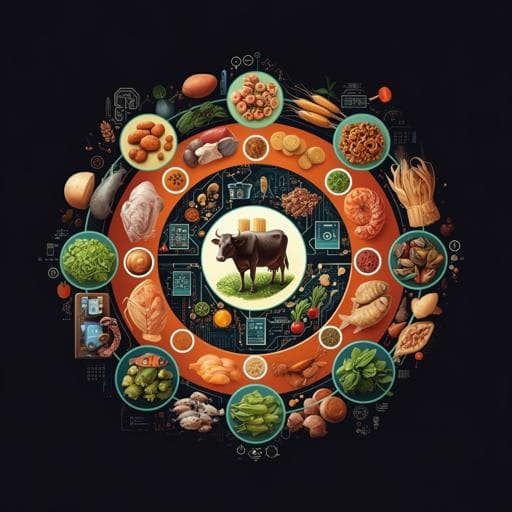
Food Science and Technology
A systematic review of the definitions, narratives and paths forwards for a protein transition in high-income countries
O. Duluins and P. V. Baret
This systematic review by Océane Duluins and Philippe Vincent Baret delves into the protein transition in high-income countries, exploring the shift from animal to alternative protein sources. It uncovers three key narratives—consumer dietary changes, technological advancements, and socio-technological transitions—while emphasizing the need for clearer definitions and systemic solutions.
~3 min • Beginner • English
Introduction
Proteins are central to diets and come from diverse plant and animal sources. While animal protein consumption tends to rise with economic development in low- and middle-income countries, its role is increasingly contested in high-income countries due to environmental, health, and animal welfare concerns tied to overproduction and overconsumption. This debate has led to conceptualizing a “protein transition” and integrating it into scientific and societal discourse. The literature approaches the protein transition from several perspectives: (1) futures of proteins across all sources, including alternative proteins and livestock substitutes; (2) specific focus on alternative proteins, covering production, consumption, acceptance, environmental impacts and narratives; and (3) futures of animal proteins and their role in food systems under multiple targets. Prior work addressed sustainability issues across protein sources but lacked a fully systematic selection due to scattered literature. This study contributes by focusing on the protein shift as a transition process and by systematically reviewing and synthesizing all articles on the protein transition to balance diverse narratives and features. The topic is salient across policy, private sector strategy, and media. Political initiatives include the EU Farm to Fork Strategy, Canadian food policy, Brazil’s National Plan for Agroecology and Organic Production, Healthy China 2030, and the UN SDGs. Private sector interest has driven investment, speculative finance, innovation and product development. Because the protein transition is an emergent, variably used concept, clarification of definitions and evidence, along with identification of knowledge gaps and debates, is needed. The objectives of this review are to (1) identify definitions and interpretations of the protein transition, (2) identify key challenges the transition aims to address, and (3) identify narratives proposing solutions to achieve it. The analysis focuses on OECD (typically high-income) countries with high meat consumption, where reductions could yield environmental and health benefits and have global ripple effects. The concept is not intended for contexts with nutritionally inadequate diets and low animal protein intake. Throughout, alternative proteins refer to insects, algae, plant-based single-cell proteins and fungi, contrasted with traditional animal proteins (meat, fish, dairy, eggs).
Literature Review
The literature on protein transition spans multiple strands. One examines futures of protein broadly, considering all sources and debates around livestock and substitutes with differing visions for consumption. A second concentrates on alternative proteins, investigating their production systems, consumer acceptance, environmental profiles and associated narratives. A third examines animal proteins’ future roles in food systems and the impacts of meeting multiple sustainability targets on production and consumption. Beyond academic discourse, the protein transition features prominently in policy agendas (e.g., EU Farm to Fork, national policies) and in private sector innovation and investment. Earlier syntheses addressed sustainability across protein sources but did not use fully systematic selection given the dispersed, multi-disciplinary nature of the field. This review addresses that gap by systematically identifying and analysing all articles explicitly engaging with the protein transition or protein shift in high-income settings.
Methodology
The review followed PRISMA guidelines. A Scopus search (September 2022) used the terms: 'protein transition' OR 'protein shift' OR 'sustainable protein consumption' OR 'sustainable protein production' in title, abstract, and keywords. Screening excluded works not dealing with the protein transition (e.g., studies on physical/thermal properties of proteins). Snowballing complemented the database search by screening most-cited references in included papers; all references with more than five citations were screened for eligibility. Inclusion criteria (all required): explicit mention of 'protein transition' or 'protein shift'; peer-reviewed; English; full text online; focus on a transition toward lower animal protein consumption in high-income/OECD settings; and explicit investigation of at least one of protein consumption, livestock production, behavioural dietary change, or alternative proteins. Exclusion criteria (any one sufficient): absence of the target terms; non-peer-reviewed; non-English; inaccessible full text; focus on production processes of meat alternatives/alternative proteins or protein thermal properties; using the protein transition only as context; focus on non-OECD countries; or framing transition as increased animal protein consumption in low-income settings. PRISMA counts: Scopus identified 439 records (3 duplicates removed; 436 screened); 395 excluded at title/abstract; 41 full texts assessed; 13 excluded; 28 included. Snowballing identified 28 records (5 duplicates removed; 23 screened); 12 excluded at title/abstract; 11 full texts assessed; 6 excluded; 5 included. Total included: 33 articles. Data analysis used NVivo 20.1 with iterative coding. Both authors independently tested initial codes on five articles, then refined and applied final codes to all 33 papers. No review protocol was registered (e.g., PROSPERO), as the study did not address a health outcome.
Key Findings
- Corpus and definitions: 33 articles met inclusion. Of these, 17 provided explicit definitions of the protein transition, 3 implicit, and 13 no definition. Among the 20 defined cases, 16 framed the transition from a consumption perspective as a shift from diets rich in animal proteins to diets richer in alternative proteins; only one mentioned reducing total protein intake. Fifteen definitions specified plant proteins; five referred to alternative proteins more broadly. Only two definitions explicitly included production-side change (reductions in both consumption and production).
- Challenges motivating the transition: Three non-mutually exclusive challenges were consistently identified. (1) Reducing environmental impacts of protein production and consumption—mentioned by all articles—covering GHG emissions/climate change, biodiversity loss, and nitrogen/carbon cycle disruption, indicating patterns beyond planetary boundaries. (2) Providing healthy diets for a growing population—nearly half of articles—highlighting rising demand, overconsumption of animal proteins in some regions, pressures on food security, and health risks associated with high intakes of red and highly processed meats. (3) Preventing ethical problems of animal welfare in industrial livestock production systems (ILPS)—about one-third—addressing welfare concerns (confinement/overcrowding), antibiotic resistance, emerging diseases, and environmental burdens linked to feed (e.g., soy-driven deforestation, pesticide use).
- Narratives and solution pathways: Three narratives emerged from proposed solutions. (1) Consumer narrative (n=13): micro/consumer level; drivers—unsustainable consumption; objective—dietary shifts; initiators—consumers and civil society; pathways—information and education, fiscal incentives/coercion, portion reduction, meatless days, “less but better” meat, nudges, cooking skills, promotion of flexitarian/vegetarian/vegan diets, and acceptability strategies. (2) Techno-centred narrative (n=10): meso/value-chain level; drivers—inefficient protein production systems; objective—develop more resource-efficient novel protein production; initiators—value-chain actors/industry; pathways—R&D in alternative proteins for food and feed (e.g., insects, seaweeds, microbial/plant-based), building value chains, and investing in enabling technologies and infrastructure. (3) Socio-technological transition narrative (n=8): macro/regime level; drivers—unsustainable protein regime; objective—transition the agri-food system from an animal-dominated regime to an alternative protein regime; initiators—research, civil society, governments, private sector; pathways—redefining regime roles and power relations, alliance and trust-building, backcasting/scenario approaches, redirecting public and private finance, and implementing new norms, regulations, and dietary guidance. Two articles were unclassified due to mismatch or overlap of solutions across narratives.
- Policy priorities by narrative: Consumer—taxes/subsidies, labelling/certification, education/awareness. Techno-centred—R&D funding, subsidies, adapted regulatory frameworks for novel proteins, public–private partnerships. Socio-technological—holistic policy frameworks overcoming silos; coordinated regional/national action plans with multi-stakeholder collaboration.
- Cross-cutting insights: Definitions are often unclear or reductionist, focusing on protein as a macronutrient and overlooking systemic roles of animal husbandry and broader food system functions. There is a frequent lack of explicit linkage between proposed solutions and specific challenges, and a mismatch between the global scale of problems outlined and the localized, behavioural nature of many proposed actions.
Discussion
The review addresses its objectives by clarifying how the protein transition is defined, why it is deemed necessary (three key challenges), and how solutions cluster into three narratives with distinct drivers, scales, initiators, and policy priorities. The findings reveal substantial conceptual ambiguity: many papers do not define the protein transition, and most that do frame it narrowly as consumption substitution without addressing total intake or production-side change. This reductionist framing risks implying nutritional interchangeability of proteins and overlooking the multiple roles of livestock in agroecosystems. The three identified narratives illuminate different levers for change—behavioural, technological, and systemic/regime-level—yet many studies insufficiently connect their proposed solutions to the stated challenges or quantify expected impacts. Addressing the research aims requires clearer, more systemic definitions and an explicit mapping of solutions to challenges, scales, initiating actors, and expected outcomes, thereby enabling complementary policy mixes rather than ex post justification of preferred approaches.
Conclusion
This systematic review identifies three main narratives of the protein transition in high-income settings: consumer-focused dietary change, techno-centred development of resource-efficient alternative protein systems, and socio-technological regime transitions. Each entails different drivers, action pathways, and policy priorities. The concept of protein transition is widely used but inconsistently defined; most definitions emphasize substitution of animal with alternative proteins, with little attention to total intake or production-side transformations. To strengthen policy and practice, future work should: (1) articulate clear, systemic definitions specifying protein types and whether substitution and/or reduction is intended; (2) explicitly link proposed solutions to the environmental, health/food security, and animal welfare challenges; (3) quantify contributions toward targets (e.g., GHG reductions, health outcomes); and (4) situate interventions by scale, initiating actors, and anticipated impact to foster complementarity across narratives and avoid fragmented or misaligned efforts.
Limitations
- Scope limited to OECD/high-income contexts; findings are not intended for regions with nutritionally inadequate diets and low animal protein intake.
- Inclusion restricted to English-language, peer-reviewed, full-text articles, potentially biasing coverage.
- Search conducted on Scopus (September 2022) with specific terms and supplemented by snowballing; relevant studies not using the target terms or outside indexed sources may have been missed.
- No registered review protocol (e.g., PROSPERO), and the review does not address health outcomes directly.
- Time-bounded corpus (majority post-2018) and evolving field may limit generalizability as new evidence emerges.
Related Publications
Explore these studies to deepen your understanding of the subject.







